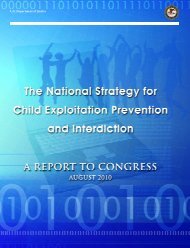Domestic Violence, with a special focus on Human Trafficking
Domestic Violence, with a special focus on Human Trafficking
Domestic Violence, with a special focus on Human Trafficking
You also want an ePaper? Increase the reach of your titles
YUMPU automatically turns print PDFs into web optimized ePapers that Google loves.
• “Are you currently in a relati<strong>on</strong>ship <str<strong>on</strong>g>with</str<strong>on</strong>g> some<strong>on</strong>e whothreatens or physically hurts you?”• “Mrs. Smith, when I see people <str<strong>on</strong>g>with</str<strong>on</strong>g> injuries of this type,it is often because some<strong>on</strong>e hit them. Is that whathappened to you?”• “What happens when your spouse loses his temper?”• “Who hit you?” (Ask this if the patient has obviousbruises, e<str<strong>on</strong>g>special</str<strong>on</strong>g>ly facial.)• “Has your partner ever harmed or threatened to harmyou or some<strong>on</strong>e you love?”• “Have you ever been forced to have sex when you did notwant to?”• “Have you ever been afraid for the safety of yourchildren?”You may want to make this kind of statement: “We now knowthat violence in the home is a very comm<strong>on</strong> problem and can bevery serious. I routinely ask all of my patients whether they areexperiencing domestic violence because no <strong>on</strong>e should have tolive in fear and because there is help available.”The American College of Obstetricians and Gynecologists hasd<strong>on</strong>e a great deal of work <strong>on</strong> domestic violence and thephysician’s role, particularly <strong>on</strong> the issue of universal screening.The following site is e<str<strong>on</strong>g>special</str<strong>on</strong>g>ly helpful to assist <str<strong>on</strong>g>with</str<strong>on</strong>g> screeningquesti<strong>on</strong>s:www.acog.org/departments/dept_notice.cfm?recno=17&bulletin=585.Additi<strong>on</strong>ally, another tool, RADAR [39] is an acr<strong>on</strong>ym created bythe Massachusetts Medical Society that many find useful tosystematically screen patients. The acr<strong>on</strong>ym stands for:Routine screeningAsk direct questi<strong>on</strong>sDocument your findingsAssess patient safetyReview patient opti<strong>on</strong>s and referralsAnother opti<strong>on</strong> would be to have the following hand-stamped<strong>on</strong> the chart:DV* Screen Yes__ No ___DV* Referral Yes __No ___(*DV is the abbreviati<strong>on</strong> used for domestic violence.)In Florida, there was c<strong>on</strong>cern that if a physician documentedthe domestic violence in a patient’s chart, some insurancecompanies would not pay the insurance benefits because theywould c<strong>on</strong>sider the problem a “pre-existing c<strong>on</strong>diti<strong>on</strong>.” This wasresolved <str<strong>on</strong>g>with</str<strong>on</strong>g> the passage of a law in Florida which prohibitsthe denial of medical or life insurance coverage for victims ofdomestic violence. [40]Finally, hospitals and other health care facilities shouldc<strong>on</strong>sider adopting a facility-wide tool to help screen fordomestic violence. In 2002, the Agency for HealthcareResearch and Quality (AHRQ) released an evaluati<strong>on</strong> tool thathospitals can use to assess the quality and effectiveness of theirdomestic violence programs. Dr. Jeffrey H. Coben, Director ofthe Center for <str<strong>on</strong>g>Violence</str<strong>on</strong>g> and Injury C<strong>on</strong>trol at AlleghenyGeneral Hospital in Pittsburgh, Pennsylvania, and AHRQ’sformer <str<strong>on</strong>g>Domestic</str<strong>on</strong>g> <str<strong>on</strong>g>Violence</str<strong>on</strong>g> Senior Scholar-in-Residence, saidthe tool has been “well received by the research communityand hospital domestic violence programs.” It can bedownloaded at the Agency’s Website at www.ahrq.gov/research/domesticviol. [41] This tool details a range of activitiesthat providers can use to address domestic violence. Thisincludes discreetly placing informati<strong>on</strong> about local domesticviolence shelters in the bathroom so the patient has access to it<str<strong>on</strong>g>with</str<strong>on</strong>g>out her abuser knowing that the informati<strong>on</strong> has beenprovided.Screening for <strong>Human</strong> <strong>Trafficking</strong>In human trafficking cases, screening for human trafficking isalso important. However, because it is not as prevalent asdomestic violence, the physician should screen when humantrafficking is suspected.A victim of trafficking may look like many of your patients andbe brought in by an existing patient. In <strong>on</strong>e case, a wealthyfamily member brought a young woman they were subjectingto domestic servitude to see their family physician. The wife/mother/trafficker thought her children would be infected bythe trafficking victim’s illness. Traffickers often bring victimsinto emergency rooms, clinics and other health care settings,posing as relatives, caring friends or legitimate employers. Hereare some indicators for both U.S. citizen and foreign-bornvictims of trafficking:• Evidence of being c<strong>on</strong>trolled• Evidence of an inability to move or leave job• Bruises or other signs of battering• Fear or depressi<strong>on</strong>• N<strong>on</strong>-English speaking• Recently brought to this country from Eastern Europe,Asia, Latin America, Canada, Africa or India• Lack of passport, immigrati<strong>on</strong> or identificati<strong>on</strong>documentati<strong>on</strong> [42]www.fma<strong>on</strong>line.org<str<strong>on</strong>g>Domestic</str<strong>on</strong>g> <str<strong>on</strong>g>Violence</str<strong>on</strong>g> in Florida: <str<strong>on</strong>g>special</str<strong>on</strong>g> <str<strong>on</strong>g>focus</str<strong>on</strong>g> <strong>on</strong> human trafficking17

















